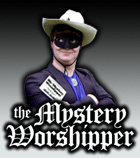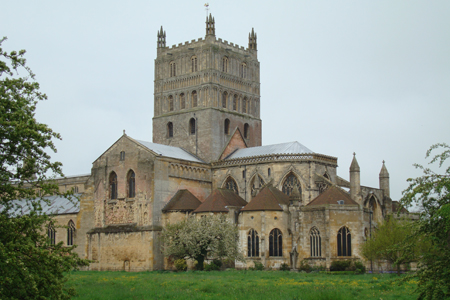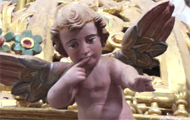| |
 |
 |
 |
| Comment on this report, or find other reports. |
 |
| Our Mystery Worshippers are volunteers who warm church pews for us around the world. If you'd like to become a Mystery Worshipper, start here. |
 |
| Find out how to reproduce this report in your church magazine or website. |
|
|
| 1613: Tewkesbury
Abbey, Tewkesbury, Gloucestershire, England |
 |

Photo: John Armagh |
 |
Mystery Worshipper:
Chris Teean.
The church:
Abbey
Church of St Mary the Virgin, Tewkesbury, Gloucestershire,
England.
Denomination:
Church of England, Diocese
of Gloucester.
The building:
You would think you were looking at a cathedral – indeed
the abbey is actually larger than 14 cathedrals and is the second
largest abbey in the country. Construction started in 1087 on
the site of a Saxon abbey, and the large Romanesque tower that
dominates the abbey was completed in the 12th century. On entering,
the first sight to amaze you is the immense nave with a high
vaulted ceiling supported by great Norman columns. As you approach
the high altar, you can see beautiful stained glass windows
on either side, but the east window in which Christ stands between
St Mary the Virgin and St Michael the Archangel is outstanding.
The main benefactors were the noble families the de Clares,
the Despencers and the Beauchamps, and they built many chantries
and chapels around the altar and choir area as well as having
themselves entombed there. On top of a chantry facing the high
altar there is a statue called The Kneeling Knight
that depicts Lord Edward Despenser in full armour kneeling in
prayer.
The church:
After the dissolution of the monasteries in which the monastic
buildings and Lady chapel were destroyed, the townspeople purchased
the abbey from Henry VIII so that they could use it as their
parish church. It serves as such to this day, although, because
of its architectural magnificence and historical connections,
it also attracts many tourists. It is a favourite venue for
concerts, hosting many BBC recording sessions. Shakespearean
and other dramatic performances are also frequent. Morning prayer,
holy communion and evensong are celebrated each day, with several
eucharistic celebrations each Sunday. They offer junior church
and other activities for young people.
The neighbourhood:
The abbey is located away from the Tewkesbury town centre on
the road to Gloucester, close to the river Avon. The area is
not residential. There is a school next door and a pub opposite,
but the abbey is otherwise surrounded by shops and restaurants.
At the back there are fields and meadows. Tewkesbury is a pleasant
well kept market town with a lot of history and a well-to-do
air about it. The battle of Tewkesbury took place nearby in
1471 and the defeated Lancastrians sought sanctuary in the abbey,
where they were pursued by the victorious Yorkists. However,
although the abbot pleaded for the slaughter to stop, they were
dragged out of the abbey to be executed in the town centre.
The cast:
The Revd Canon Paul Williams was the celebrant and preacher.
He was assisted by two other clergy but I was unable to find
out their names.
The date & time:
Holy Cross Day, 14 September 2008, 11.00am.
What was the name of the service?
Sung Eucharist with Festal Entry.
How full was the building?
Surprisingly and disappointingly only about a third full –
I would say there were about 150 people in the congregation.
There was a complete mix of ages from young to old. I would
say most were well dressed.
Did anyone welcome you
personally?
There was a team of sidespersons giving out hymn books and service
leaflets. I was greeted with "Good morning."
Was your pew comfortable?
This was about the most comfortable I have ever been in a church. We had very comfortable chairs; the back of the chair in front contained space for books and leaflets and the kneeler was slotted in underneath. The kneeler was the most comfortable kneeler I have ever knelt on! It was deeply cushioned and springy.
How would you describe the pre-service
atmosphere?
It was quiet and reverential.
What were the exact opening words of the
service?
"Good morning and welcome to Tewkesbury Abbey on this Holy
Cross Day."
What books did the congregation use during the
service?
The English Hymnal. We were handed a specially printed
service leaflet that listed the mass setting, the hymns, the
collect, the readings, the psalm and the gospel. There was also
a leaflet entitled Welcome to Tewkesbury Abbey that
was mainly about parish news.
What musical instruments were played?
One of the abbey's three pipe organs, this one dating from the
17th century and reputed to have been played on by the poet
John Milton; hence it is often called the Milton organ. The
history of the instrument is long and fascinating and is detailed
on the abbey's website.
Did anything distract you?
When the choir sang Psalm 22, either the choir was singing too
softly or the organist was playing too loudly, but I couldn't
make out a word of it! It was a good job the leaflet contained
the words of the psalm! At first I thought the choir should
be singing better and I should be hearing soaring sopranos and
resonant basses. Then I had to pinch myself and remind myself
that this was not a cathedral choir but a humble church choir
and that they were doing their best. On reflection, I think
the organist should have played more quietly, but I suppose
she was just enjoying herself on that magnificent organ.
Was the worship stiff-upper-lip, happy clappy, or
what?
It was glorious Anglo-Catholicism at its very best. The procession
of clergy and choir was led by a thurifer and boat girl, followed
by the crucifer flanked by two servers, then the clergy and
choir. But the thurible wasn't just swung, it was rotated in
complete vertical revolutions the whole time. I must admit I
thought to myself, "I wouldn't like to get in his way!" The
service was the traditional form of Order 1 from Common
Worship and was most reverential and dignified. The collect
was chanted and the Bible was carried with great solemnity to
the west end where the gospel passage was chanted. There was
much censing, genuflecting and crossing. The sun shone through
the medieval windows, and I felt I was in heaven.
Exactly how long was the sermon?
12 minutes.
On a scale of 1-10, how
good was the preacher?
9 – Canon Williams spoke eloquently and clearly and did
not appear to follow any notes. He produced a well prepared
sermon. He didn't crack any jokes or tell any anecdotes, which
I think would have been inappropriate. I was not watching the
reaction of other people and can only tell you that my companion
didn't fall asleep. The canon certainly held my attention, and
I doubt if anyone else could have put his points across more
succinctly or in a shorter time.
In a nutshell, what was
the sermon about?
It was a comparison between Cicero's view that crucifixion was
barbaric and cast doubt on the Roman claim of civilization,
and Paul's view that it is a message of hope and a sign of love.
We need hope to give us shape and direction in our lives. But
when we hope we become vulnerable. Some people give up hope
to avoid disappointment, but to lose hope is to die in the midst
of life. He referred to the reading from Numbers 21:4-9 (Moses
was ordered by God to make a bronze serpent to act as a saviour).
God then sent his only son, who suffered death, even death on
a cross, so that in his resurrection hope was born again. He
concluded that Cicero was wrong and Paul was right.
Which part of the service
was like being in heaven?
The procession, the ceremonial actions, the reverential demeanour, the beautiful elicitation of the prayers, the sun shining through the windows. I was in heaven for the entire service.
And which part was like being in... er... the other place?
At times I felt the organ was being played too loudly and sometimes, surprisingly, the acoustics seemed to prevent some readings being heard clearly.
What happened when you hung around after the service looking lost?
After the service the congregation was invited to attend the
internment of the ashes of a local lady. Some people left (I
assume those who knew her) and some remained (I should think
those remaining were all visitors). As soon as the service had
ended, fresh tourists flooded in.
How would you describe the after-service
coffee?
There wasn't any, but there is a nearby refectory where you can purchase all sorts of refreshments.
How would you feel about making this church your regular (where 10 = ecstatic, 0 = terminal)?
10 – If I lived in Tewkesbury I would definitely make this my regular place of worship.
Did the service make you feel glad to be a
Christian?
Yes. It was a most uplifting and heavenly experience.
What one thing will you remember about all this in seven days' time?
That thurifer rotating his censer in huge circles when leading
the procession and miraculously without incident! |
|
|
 |
 |
 |
| We rely on voluntary donations to stay online. If you're a regular visitor to Ship of Fools, please consider supporting us. |
 |
 |
 |
| The Mystery Pilgrim |
 |
| One of our most seasoned reporters makes the Camino pilgrimage to Santiago de Compostela in Spain. Read here. |
 |
 |
 |
| London churches |
 |
| Read reports from 70 London churches, visited by a small army of Mystery Worshippers on one single Sunday. Read here. |
| |
|
|
|
|


